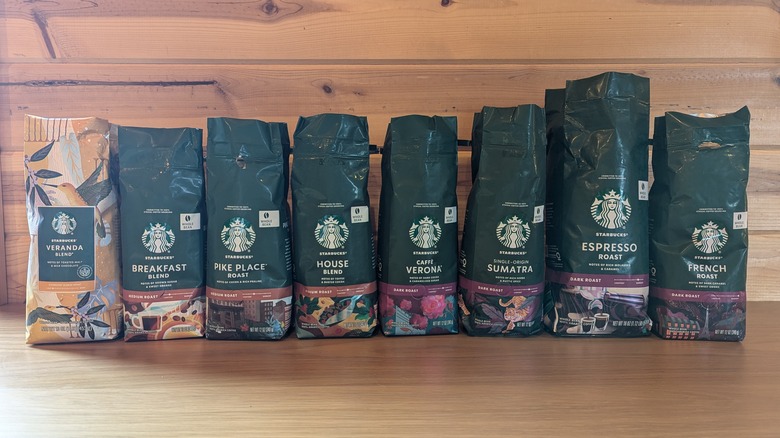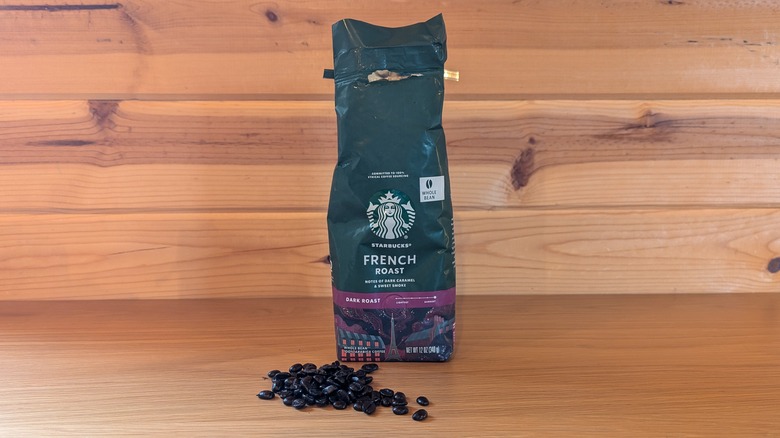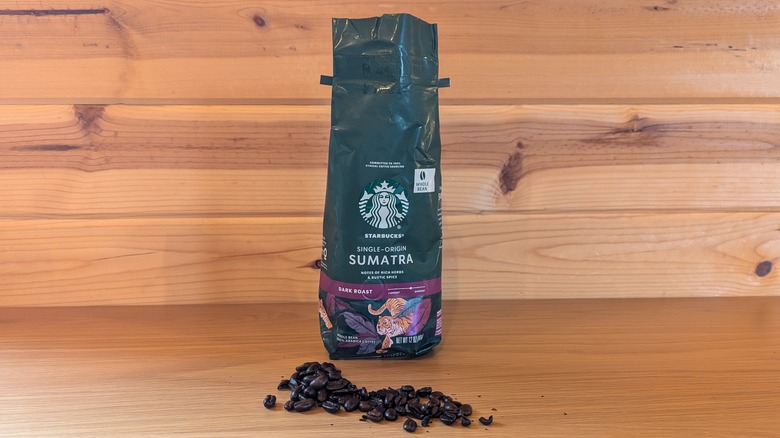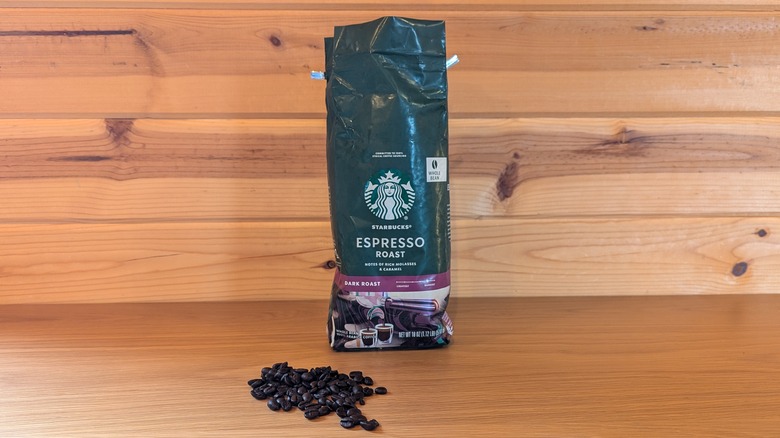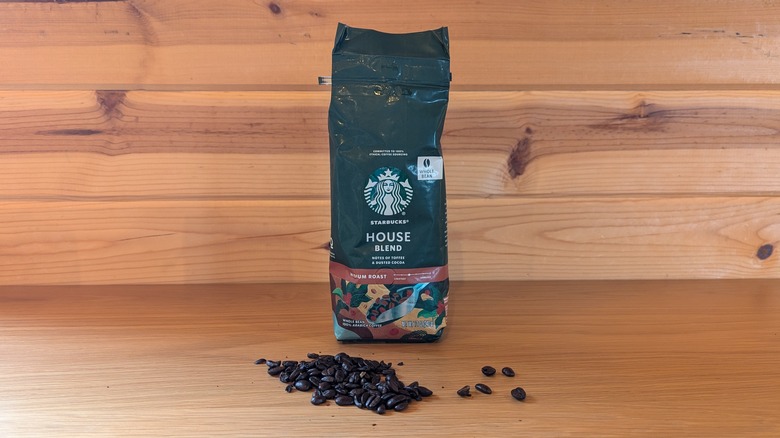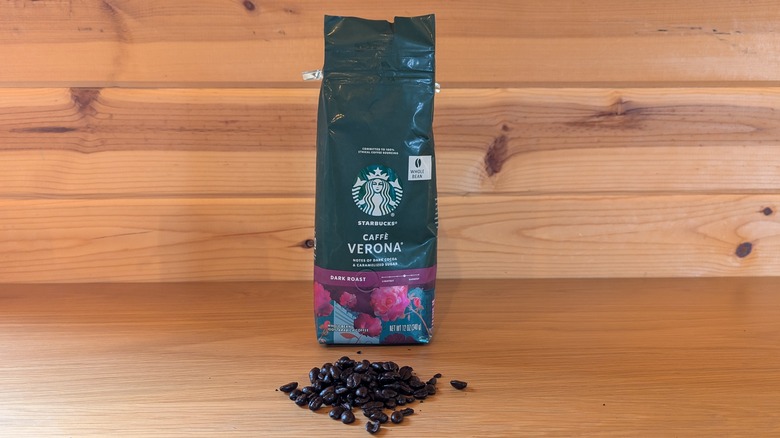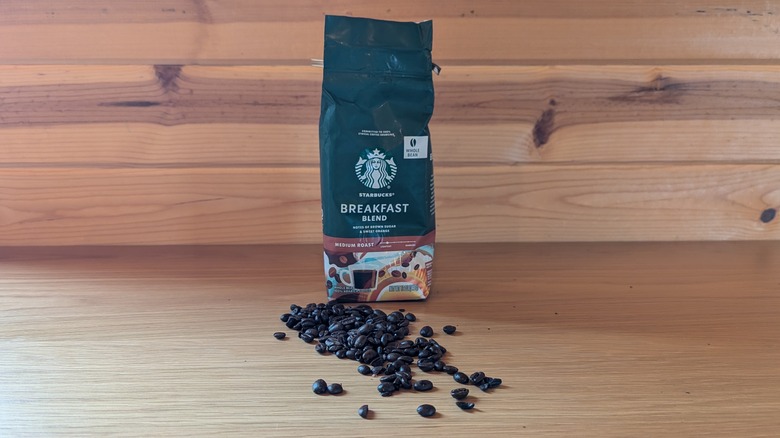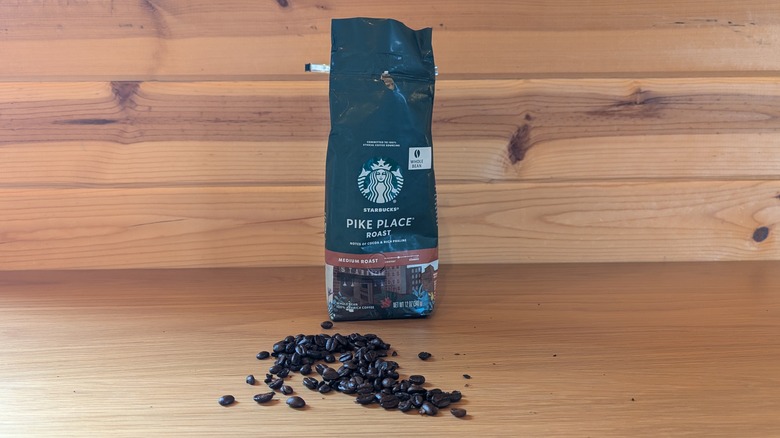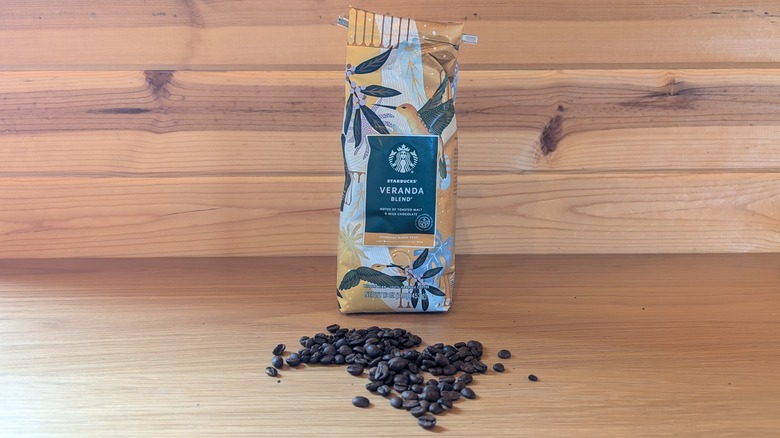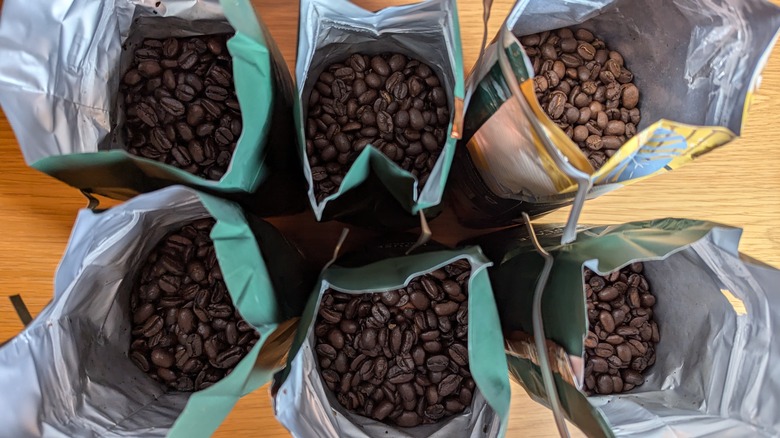8 Starbucks Whole Bean Coffees, Ranked
There isn't a whole lot of middle ground when it comes to coffee. Generally, you either are a coffee drinker and absolutely have to have it, or it's not your jam and you cannot understand what all the fuss is about. If you are a coffee drinker, you've most likely dabbled in the coffee giant, Starbucks, before. Its beans are widely distributed on a national (and even international) scale, which makes it easy to find one or more varieties in a typical grocery store. And if you're a coffee drinker, you know that coffee from freshly ground beans will give you the freshest, most aromatic cup. So, you might want to try your hand at grinding your own.
If you know the brand but are looking to take more of a deep dive into Starbucks' whole bean offerings, this is your breakdown of where to start. I've rounded up some of the classic and most commonly found blends, ground them to perfection, brewed them a few different ways, and drank one too many cups in order to decide which one was the best. Before that over-caffeinated jittery state hit, I ranked each one on its expression of flavor, acidity, bitterness, sweetness, body, and overall balance. I should note that my personal roast preference as of late is a light roast, so I naturally favored the blends that were light to medium over the darkest of the dark. Regardless, there is a ton of variation across Starbucks' bean blends, so you're bound to find one that works for you.
8. French roast
Starbucks whole bean French roast is the darkest of the dark. It hits the far right end of the roasters scale, in true French roast form. The beans are 100% Arabica and have a clear oily sheen, which translates to a pretty smoothly textured cup of coffee. While the aromas are dense and rich with nearly-charred caramel, wood, and smoke, the overall profile in the cup lacks that inherent French roast flavor.
Rather, the overall profile is a muted version of what the aromas express. It gives up less wood smoke and kind of peters out without offering any assertiveness. For someone who is easing into French roasts, this might be appealing, as it's less aggressive overall, but I found the combination of lower acidity and lack of depth in the caramel notes to leave something to be desired. In the end, it could have had more distinct flavors, more caramelization, and a longer finish.
7. Sumatra
Starbucks' Sumatra is an Indonesian dark roast that has been in its lineup since 1971. Sumatra coffee is typically quite distinct; it expresses earthy and spicy notes with full-bodied and well-textured brew. Starbucks' Sumatra delivers a bit of that, but it lacks the little bit of punch that you would expect to find in beans from the region. Like the lower-ranked French roast, the Sumatra coffee beans are 100% Arabica. They have a relatively dark mahogany color with a shiny, oily finish. The aromas do offer an inherently dark and earthy profile, however, they lean more towards tobacco and wood smoke notes and lack a sweet richness and definitive spice characteristics.
The body is full and relatively dense with low acidity. This makes the coffee smoothly textured and heavy in the cup. While this single-origin coffee is fine, it's not the best Sumatra coffee I've ever had. The earthy qualities trend a bit harsh and need a better balance of sweetness. I found myself wanting more acute earthy characteristics of mushroom and distinct spice. In other words, if you're going to do Sumatra, like do it. This just felt a bit muted. In regards to the rest of the Starbucks whole bean lineup, the Sumatra falls on the lower end because it just misses the mark for what this single-origin brew should be.
6. Espresso roast
This is Starbucks's burly, staple espresso. If you walk into the coffee shop and order a latte or an Americano, the shot is likely pulled from these beans. It's a long-standing blend for the brand and was first created in 1975. This "multi-regional" whole bean blend is made with 100% Arabica beans and plays a large part in so many different Starbucks drinks.
Dark truly means dark here. It ticks the second to-last blip on the Starbucks roast scale — which means that its flavor is quite pronounced. It's a rich and sultry blend with deeply roasted beans. Overall, I thought this whole bean blend was unbalanced. It was only pleasant if I combined it with a good portion of steamed milk to knock back the intense bitter notes. On its own, I found that the molasses and caramel flavors were overpowered by burnt notes and the coffee's overall bitter profile. I would have loved more rich aromas and a bit better balance in terms of sweet and bitter, which would have made for a more even shot. While a straight shot of this would be too overwhelming and would leave an unpleasant bitter finish, a shot as the foundation of a multi-dimensional coffee drink could and would be more palatable.
5. House blend
It makes sense that the house blend was Starbucks' OG coffee that they presented to the world back in 1971. The medium roast, whole bean blend isn't anything unexpected or foreign to an everyday coffee drinker, but that's kind of the point. It's simple and straightforward with amicable toffee and cocoa notes throughout. This blend is made with 100% Arabica beans. Although Starbucks classifies it as a medium roast, I think other coffee connoisseurs would argue it leans more towards a dark, chestnut-hued bean.
The balance in the house blend is pretty even; the cup gives up a bit more sweet fruit matched with richness from the toffee and cocoa notes. That being said, I wouldn't say this blend is particularly forthcoming with any distinctive traits. It's pleasant enough to drink, but overall lacks a bit of oomph and ends up falling a bit flat in the cup. There is also a lingering bitterness, something akin to burnt almonds, that catches on the tongue and leaves behind a pretty mediocre finish. I would expect that a coffee conglomerate like Starbucks would have a house blend that hit a few more high notes. Maybe it's time to revisit the blend and method after 50-plus years and make some revisions? Compared to the rest of the beans, this one ranks pretty high. But, there are far better coffee blends to choose from.
4. Caffè Verona
The Starbucks Caffè Verona leans slightly dark on the coffee roast spectrum. It's a multi-regional blend that has been around for decades. Caffè Verona boasts a rich body with notes of dark cocoa powder and turbinado sugar. The Arabica beans are pretty dark and shiny, which further suggests that this is a dark roast.
If you are in the market for an aromatic and richly-brewed cup of coffee, you might want to grab a bag of this blend. It has a relatively pungent aroma with rich chocolate and a bit of charred cedar. Even though the bitterness and acidity are relatively low, the brewed cup still feels in balance. It expresses a very smooth and velvety texture that feels robust and rich. The caramelized sugar, bitter dark chocolate, and charred cedar all come through with a teeny tiny edge of fruity brightness. Overall, it's not a bad whole-bean blend from Starbucks, especially if you are looking for something rich and rounded.
3. Breakfast blend
The breakfast blend is close to a true medium roast. Starbucks notes that it is one of the lighter offerings it has. The brand came up with it in 1998 to appease the coffee drinker who has, let's say, a more delicate palate. The lighter-roasted Arabica beans do offer up a bit more nuance in terms of aroma and taste. There is subtleness and character in the toastiness of the cup, yet the mouthfeel is still smooth and light.
The acidity is there, but in a pretty mild way. The breakfast blend has a bit more generous sweetness than many of the other blends; it offers up warm brown sugar notes, a mild citrus profile, hints of toasted almond, and a bit of dark chocolate. While the profile is decent, the flavors don't carry over much or linger after the fact. I would say this was one of the better blends I've had from Starbucks, as it really brews up with more balance and sweetness. That being said, I wouldn't describe these beans as complex or particularly showy compared to Starbucks' other blends.
2. Pike Place
Starbucks' Pike Place roast is an ode to the original location in Seattle's Pike Place Market. The blend is a mash-up of Latin American Arabica beans, roasted to a dark medium. At this point, the Starbucks roast scale feels like it's kind of in its own little world. Out of the bag, the beans have an oily sheen and aromas of brown sugar, cocoa powder, and something vegetal characteristic — which is almost along the lines of edamame.
The first sip is pretty pleasant, with the same caramelized sugar and cocoa notes ringing through, though they're not over-pronounced. Then, the carob flavor comes in, along with something slightly woodsy, like almond skin, before finishing with a green, herbaceous flavor. While the green profile was subtle, it did indicate some undeveloped flavors. The cup was smooth with very little acidity, but it had pretty good structure. While this coffee drank sweeter (in a good way) than Starbucks other blends, there was still a somewhat unpleasant bitter edge that lingered on the finish. It wasn't quite acrid, but I wanted a bit more sweet praline to hit at the end. Overall, the Pike Place whole bean blend had more going for it than many of the other coffees in the tasting, with better balance and less bitterness. I would say these beans are worth your time.
1. Veranda
Veranda is Starbucks' lightest roast. It's very light and is classified as "blonde." The 100% Arabica whole bean blend is from Latin America and surely is the brightest expression of all the coffees in the lineup. The aromas of toasty malt and milk chocolate are vivid and carry over into the cup. Meanwhile, the lighter and brighter roast gives up more fruit notes, like pineapple and orange, which are matched by a pleasantly sweet chocolate flavor.
The mouthfeel of the Veranda blend leans a bit thinner, but it still has substance to it. It's definitely still a smooth cup and comes across pretty balanced without an overwhelming acidity. There's also an underlying sweetness that shines with every sip. It's a pleasant and pretty straightforward whole bean blend that doesn't offer up anything extraordinary — but it's a good version of itself and its simplicity. Compared to the other beans I tried, the Veranda felt the most elevated and came across with the best overall balance and flavor profile. Certainly, if your taste preferences lean more towards the lighter end of the scale, the Veranda blend is worth the buy, grind, and brew.
Methodology
I ground the beans for each blend before brewing them both in an AeroPress and as a pour-over. I sampled each coffee black, then tried each with a splash of whole milk. Since I found subtle differences in texture and flavor between the brewing methods, I was able to combine my tasting notes from each to formulate my overall impression of the beans.
I was looking for a cup of coffee that, ultimately, I wanted to drink more of. In short, I wanted something with a pleasant aroma, good acidity, rich notes, fruity flavors, subtle sweetness, and a lingering finish. I also considered the body and texture for each brew that I tried. While tasting is always a subjective process, I considered the overall profile of each roast to give an well-rounded assessment of its quality and balance.
